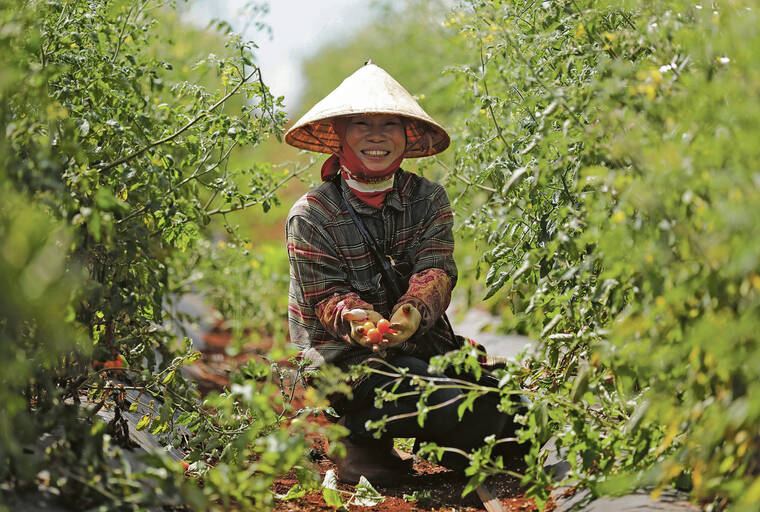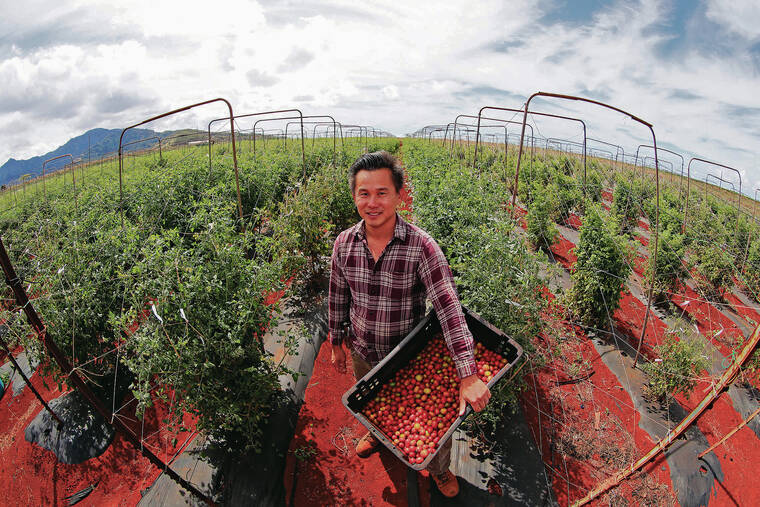Tomatoes may be the backyard gardener’s favorite crop to grow, but they’re also a popular entree choice for bugs and birds, and a buffet for fungi, bacteria and viruses.
It’s enough to make anyone throw their hands up in despair, but commercial tomato growers Neil and Shin Ho tell gardeners not to give up in frustration.
“You just have to learn from it,” Neil Ho said. “Every time you do a planting, you have to pick up something from past experience.”
For the past 16 years, he and his sister have run Ho Farms, which was started by their father and mother, Wei Chong and Le Xieng Ho, in Kahuku 30 years ago. Immigrants from Laos, their parents still help out full time.
“They don’t know how to not work,” said Shin Ho.
While the farm, which recently moved to Wahiawa, also grows several kinds of vegetables, its signature crop is tomatoes. The fruit is picked at the peak of crisp ripeness and delivered to market the next day, as opposed to imported fruit picked too green off the vine, Neil Ho said.
They only grow the small, cherry or grape-sized tomatoes in nine varieties, the red ones being in the most demand, Shin Ho said. Other types included in their popular family pack are the elongated Golden Grape of dazzling gold with its extra crunchy texture and sugary taste; the yellow-green Snow White, watery and tart with a sweet aftertaste; the gold-orange Kahuku Golden, finely textured with almost a fruity flavor; and the thicker-skinned, sweet Indigo Kumquat, yellow with streaks of purple.
While growing tomatoes commercially on six acres is far different from a home gardener’s backyard plot, the Hos wage constant battles against similar adversities and urged gardeners to just keep trying.
“There’s no recipe that produces good results. We’re challenged every day,” said Shin Ho. “Spotted wilt is very common, we have bacterial wilt, we have yellow leaf curl all the time.”
Don’t get her started on the bugs (such as aphids, leafhoppers, beetles and whitefly) that wreak havoc in the summer, and the weeklong bouts of rain that can wipe out an entire crop.
“It’s just a natural cycle,” she said. “The plant itself is not meant to last forever.”
What offsets the damage that occurs in spite of years of professional know-how is that they always plant more than they need, Shin Ho said.
“We only harvest the good fruit and we dispose of the stuff we can’t sell. That is the way most agricultural operations work because we are in the business of selling perfect produce.”
“We only grow small (cherry-sized) tomatoes, we don’t grow big tomatoes,” she said, as the percentage of success is much higher for smaller varieties. She recommends that backyard gardeners start with the smaller sizes, as well as the hybrid varieties rather than the more finicky heirloom tomatoes.
Large tomatoes require a lot more attention and nutrients, and the plants don’t bear as much fruit as cherry tomatoes, which produce six to 10 fruits per cluster. For example, if a two-pound tomato is damaged by insects or birds, you have to wait several weeks before another shoot grows, whereas with cherry tomatoes, only a few fruit in the cluster may suffer damage, she said.
Hybrids, which are more disease-resistant and hardier than heirloom tomatoes, would be easier for the home gardener to grow. The majority of the tomatoes grown at Ho Farms are hybrids of indeterminate varieties, which grow rather large and have multiple fruiting cycles, she said. Determinate varieties have a limited size and only bear fruit once, but might be preferred by gardeners who have small yards.
The growing cycle of indeterminate tomatoes is 100 to 120 days, depending on the potency of the sunlight. However, home gardeners who prefer a shorter wait — and a more manageable plant size — should choose determinate varieties that produce in 55 to 60 days, Shin Ho said.
Growing tips
The Hos shared several basic growing tips that can be used by the backyard gardener:
>> Be sure tomatoes get at least six hours of full sun a day to avoid diseases, particularly fungal, and other problems.
>> Don’t over-water, which could drown the roots and lead to disease. Neil Ho said established plants should only be watered every three days, though seedlings need more frequent watering.
“The more you restrict water, the better the taste, the more concentrated the tomato flavor,” Shin Ho added.
>> Fertilize at key points in the cycle. Fertilizer with a NPK of 10-20-20 and chicken manure are applied during soil preparation, Neil Ho said. While the plant is flowering, add potassium nitrate to prevent the flowers from falling off and the fruit from growing very small and easily falling off. Thirdly, he applies a 20-20-20 water-soluble fertilizer right before fruiting.
>> Vary the kinds of pesticides used and be consistent. Insects will become resistant to a spray, so the Hos constantly transition from one product to another to ensure effectiveness, he said. They try to keep spraying to a minimum because the more of a pesticide they spray, the more they’ll have to use for it to be effective.
“There is no magic bullet,” Neil Ho said, but some of the insecticides he can recommend to home gardeners are malathion or Sevin SL for high infestations, and neem oil to maintain control when pests aren’t rampant. Be sure to spray any solution under the leaves and be diligent about following the recommended schedule. Also, to minimize stress on the plant, be careful that the mixture is not too strong, and that the spray is applied in the early morning or evening when it’s not too hot or sunny, he said.
While the farm, as a commercial operation, isn’t allowed to use homemade remedies for liability reasons, he has found that a mixture of soap and water (about 2 ounces per gallon) is very effective for insects, and baking soda and water (1 to 2 ounces per gallon) for fungal infections.
For better fruit and easier harvest, Neil Ho recommended staking plants to keep everything off the ground and less vulnerable to insects and disease. While some growers prune their plants, Ho Farms does not because it’s too time-consuming and labor-intensive. Netting is advisable to keep birds from eating the fruit, but the farm doesn’t use it because it’s too expensive to install it over such a large area.
Watch the weather
Home gardeners also need to take into account the ever-changing weather conditions of their location and adjust their planting methods, as Hawaii has vastly different microclimates that can vary in as short a distance as 10 miles away, Neil Ho said. For example, in a wet, cool area like Manoa, summer would be an ideal time to grow tomatoes, but for dryer Wahiawa, spring/early summer would be best, before it gets too hot and insects overwhelm the crop.
Ho Farms was originally located for 20 years in rainy, windy Kahuku, then gradually expanded to Hoopili in Ewa Beach in 2013, where it was hot. The farm recently moved to Wahiawa where it’s a lot cooler, he said. The farm still operates its packaging plant in Ewa Beach.
“As we’ve gone to these three different locations, we’ve actually got to know the weather and really learn how the climate changes in each area,” he said.
“In the Ewa Plains, the insect population is just uncontrollable. When the bugs happen, regardless of what you do, there is no saving your crop, that’s what I learned.
“In Wahiawa, the nights are cooler, the (bug) population seems to not get crazy, out of hand, but we get a lot of fungal disease because there is a dew in the morning; and if it doesn’t dry up, that leads to a mildew problem and a blight problem, and it just spreads. Where, in Ewa, we never had a fungal problem.”
After years of stressing out over every setback, Neil Ho now rolls with them.
“It’s just part of the business,” he said. “You’re going to lose a ton from weather or unforeseen circumstances, but you just gotta keep going. Get ready for the next planting.”
His advice to gardeners?
“Don’t give up because the plant didn’t make it. They’ve just got to do it again, and adjust things accordingly.”
—
LOCAL VARIETIES
Desmond Ogata, manager of the University of Hawaii Seed Lab, recommends several tomato plants that were bred and selected to adapt to the state’s warmer sub-tropical climate and for resistance to the ubiquitous nematode pest.
The Kewalo and Healani are heirloom determinate bush varieties with excellent medium-sized tomatoes that have proven track records at the UH, said Ogata, a plant disease diagnostician at the Agricultural Diagnostic Service Center, under the College of Tropical Agriculture and Human Resources (CTAHR).
”Kewalo is our most popular variety by far and sought after by backyard growers. The fruits are very tasty and folks comment that it has a real tomato flavor over store bought varieties from the mainland suppliers,” he said.
The N63 (no nickname) is an indeterminate hybrid vine with medium-sized fruit that is ideal for commercial growers, though the home gardener may find it too much work to stake the branches away from pests off the ground. Indeterminate plants can be harvested for extended periods with proper care.
The Komohana grape tomato is a hybrid that is “very popular and folks rave about how prolific a producer this variety is,” producing heavy clusters of fruits, he said. Branches need a support system, such as the round tomato cage, before the plant gets to its flowering stage.
These varieties have fared well under the varying microclimates of Hawaii better than mainland varieties, he said. To order seeds, visit ctahr.hawaii.edu/seed Opens in a new tab.
“I just tell folks to just give it a try as that won’t hurt, and see how they perform given the conditions in your yard.… Having success in the garden is not a given each time around. Mother nature is always challenging us every step of the way.”
—
FOR MORE
If you have gardening questions, you can contact a master gardener through the University of Hawaii agricultural extension service. To find your local office, visit 808ne.ws/UHMGhelplines Opens in a new tab.
Ho Farms
>> Info: hofarmshawaii.com Opens in a new tab
When buying seeds, Shin Ho recommends johnnyseeds.com, which offers a large selection of tomatoes.
Is there a gardening topic you’d like to read about in the Garden Variety column? Email Pat Gee at pgee@staradvertiser.com with your request.








